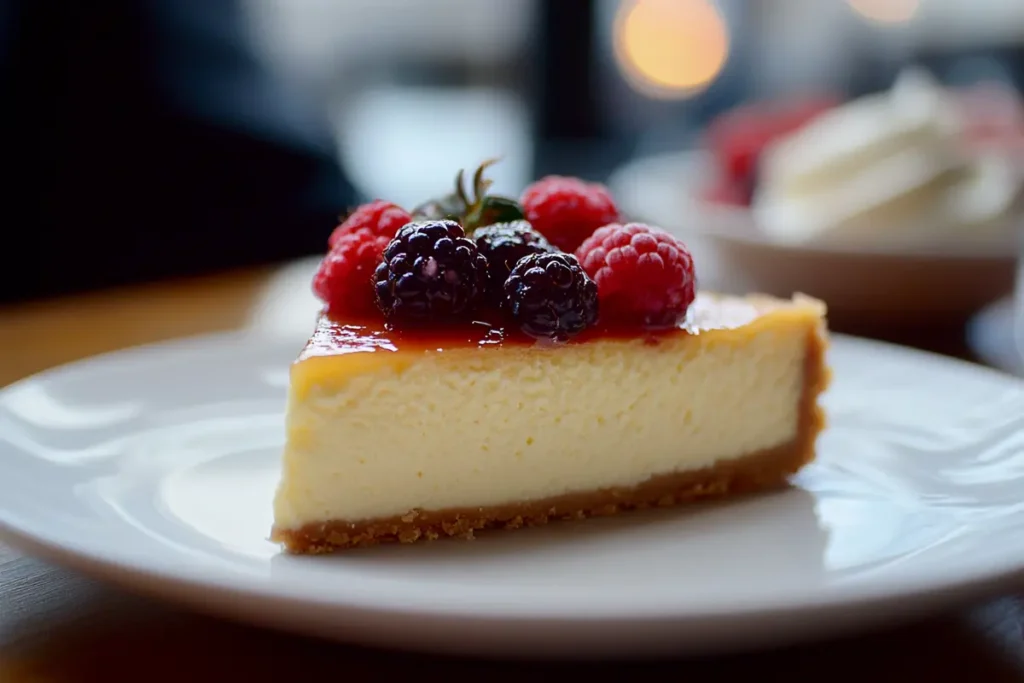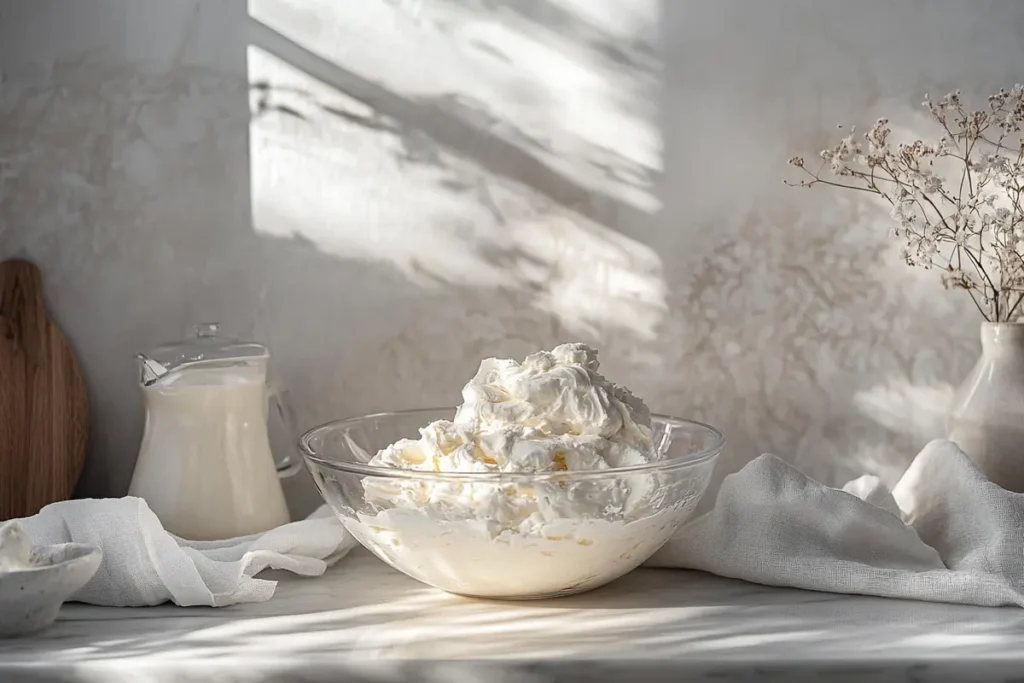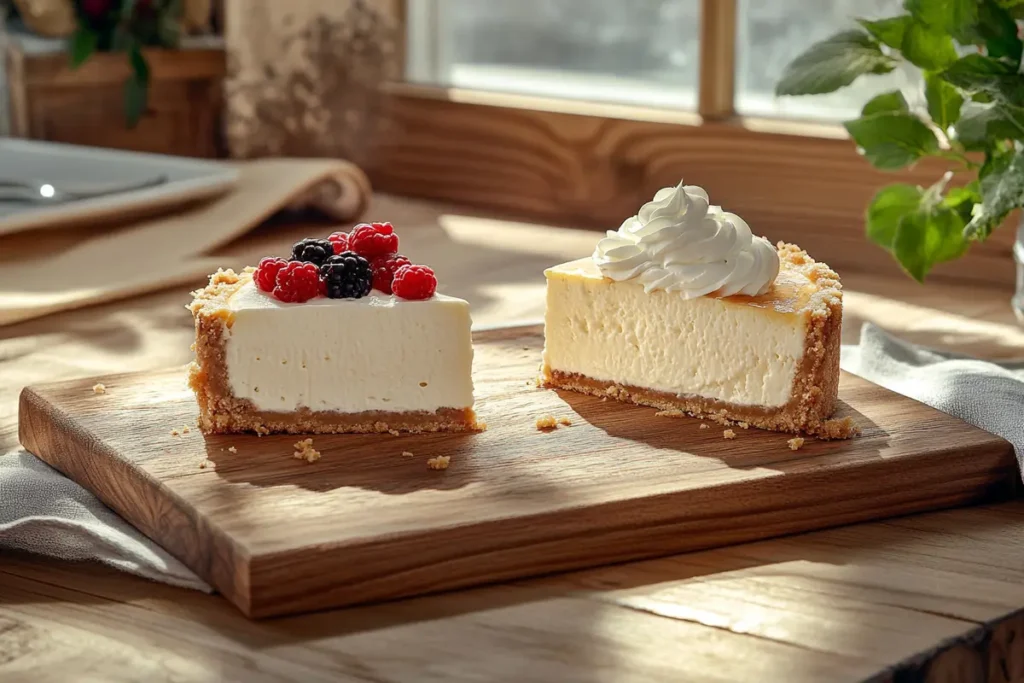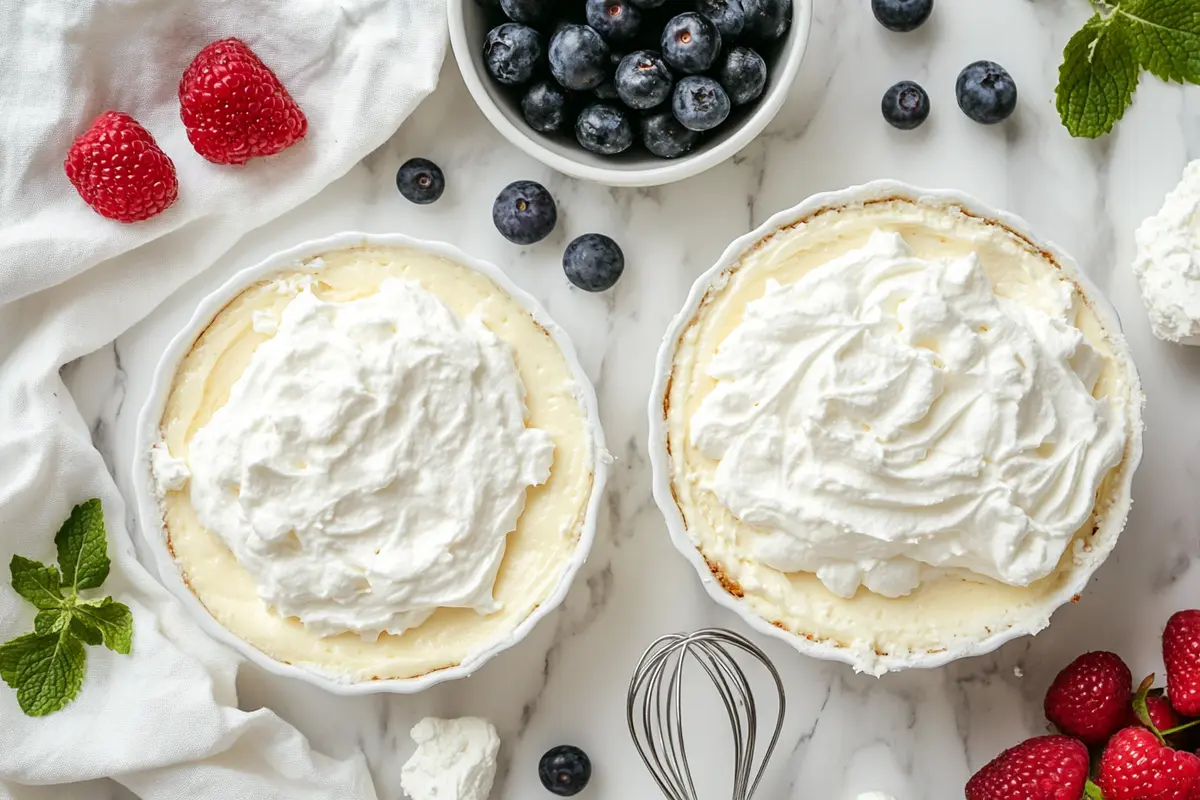Introduction to Cheesecake Ingredients
Core Ingredients of a Traditional Cheesecake
Sour cream or whipping cream better for cheesecake This question plays a crucial role in achieving cheesecake’s luxurious, melt-in-your-mouth texture. But that magic doesn’t happen without a few core ingredients. A traditional cheesecake typically calls for:
- Cream cheese – the base that makes cheesecake rich and smooth.
- Sugar – to balance the tangy and creamy notes.
- Eggs – the binding element that holds the batter together during baking.
- Cream – often in the form of sour cream or whipping cream, which plays a pivotal role in determining texture and flavor.
Role of Dairy in Cheesecake’s Texture and Taste
The type of cream you choose significantly influences the final product. Dairy doesn’t just add moisture—it’s responsible for that creamy dreaminess we all love.
- Sour cream enhances the dense and velvety texture.
- Whipping cream makes cheesecakes light and airy.
Common Types of Cheesecake Recipes That Use Sour Cream vs. Whipping Cream
Depending on the recipe, you’ll notice that certain styles of cheesecake use one cream over the other:
- New York-style Cheesecake: This decadent classic almost always calls for sour cream to achieve its signature dense, tangy filling, as seen in our blackberry cheesecake recipe.
- Classic Creamy Cheesecake: These lighter versions often opt for whipping cream to make the texture soft and fluffy.
Now that we’ve covered the essentials, let’s explore how sour cream and whipping cream stack up against each other!
Sour Cream in Cheesecake
What Is Sour Cream, and Why Is It Used in Cheesecake?
Sour cream is a thick, tangy dairy product made by fermenting cream with lactic acid bacteria. This fermentation process gives it that signature tang and a luscious, spoonable consistency. But why is sour cream a common choice for cheesecake?
In many recipes, especially New York-style cheesecakes, sour cream is a must-have for creating a rich, dense filling with a hint of tanginess that complements the sweetness. It balances out the flavors and adds moisture without making the batter runny.
Advantages of Using Sour Cream in Cheesecake

Many bakers reach for sour cream because of its unique properties:
- Rich, tangy flavor: The slight tartness elevates the sweetness, making each bite more complex.
- Creamy, dense texture: Sour cream thickens the batter, resulting in a luxurious, velvety mouthfeel.
- Moisture without weight: Unlike heavier alternatives, sour cream keeps the cheesecake moist but not overly rich.
Disadvantages of Sour Cream in Cheesecake
While sour cream brings a lot to the table, it’s not without its quirks:
- Heavier texture: If you’re aiming for a lighter, airier cheesecake, sour cream may not be your go-to.
- Prone to curdling: If your oven temperature is too high or you overbake, the sour cream can cause cracks or graininess in the cheesecake.
Ideal Recipes and Situations for Sour Cream Cheesecake
Sour cream shines in certain recipes. You’ll want to use it when:
- You’re baking a dense cheesecake like New York-style cheesecake or trying a unique twist like our sweet potato cheesecake recipe.
- You prefer a no-bake cheesecake with a bit more tang to offset the sweetness.
- You’re creating layered cheesecakes where you want a thick, stable layer.
Expert Tips for Using Sour Cream in Cheesecake
Want to master using sour cream? Here are a few insider tricks:
- Room temperature everything: Let sour cream and cream cheese sit out for 30 minutes before mixing to prevent cracking.
- Avoid overmixing: Incorporate sour cream gently to avoid whipping in too much air, which can lead to cracks.
- Low and slow baking: Use a water bath and bake at a low temperature to ensure that the batter cooks evenly.
Sour cream may be tangy and creamy, but how does it compare to the light and fluffy texture that whipping cream creates?
Whipping Cream in Cheesecake
What Is Whipping Cream, and How Is It Different from Heavy Cream?
Whipping cream is a type of dairy cream with a fat content of around 30-36%, making it ideal for adding volume and lightness to desserts. It’s slightly lighter than heavy cream but can still be whipped into soft peaks. The primary difference between whipping cream and heavy cream lies in their fat content—heavy cream has a slightly higher fat percentage, making it richer and denser.
In cheesecake recipes, whipping cream is often added to create a light and airy filling. This works especially well in recipes where the goal is to achieve a soft, creamy, and almost mousse-like texture.
Advantages of Using Whipping Cream in Cheesecake

- Airy, fluffy texture: When whipped, the cream introduces air into the batter, making the cheesecake softer and more cloud-like.
- Mild, creamy flavor: Unlike sour cream, whipping cream has a subtle sweetness that complements rich flavors without overpowering them.
- Versatility: Whipping cream can be used in both no-bake and baked cheesecakes to create a light consistency.
Disadvantages of Whipping Cream in Cheesecake
- Less structure: Whipping cream adds air, which can make the cheesecake less stable, especially in layered or heavy cheesecakes.
- Diluted flavor: Compared to sour cream’s tanginess, whipping cream lacks a punch of flavor and relies more on the cream cheese and added ingredients for taste.
- Overbeating risk: If you whip the cream too long, it can turn into butter or separate, affecting the consistency of your cheesecake.
Ideal Recipes and Situations for Whipping Cream Cheesecake
Whipping cream is the perfect choice when:
- You’re making a no-bake cheesecake or mousse-style dessert.
- You prefer a light, fluffy filling that feels less dense than traditional cheesecake.
- You’re adding other rich toppings, like caramel or chocolate, and want the filling to stay light.
Expert Tips for Using Whipping Cream in Cheesecake
- Chill before whipping: Cold whipping cream holds its shape better, so keep it in the fridge until just before you use it.
- Fold, don’t stir: Gently fold the whipped cream into the batter to maintain the airy structure.
- Avoid overwhipping: Stop as soon as soft peaks form to prevent the cream from becoming too stiff or grainy.
Whipping cream brings a delicate, fluffy texture to the table, making it ideal for airy cheesecakes. But how do the two stack up in a direct comparison?
Comparative Analysis of Sour Cream vs. Whipping Cream

Texture Comparison
When it comes to texture, the difference between sour cream and whipping cream is like night and day.
- Sour cream gives cheesecake a dense, velvety structure. The added acidity thickens the batter, creating a smooth, compact finish that’s characteristic of New York-style cheesecakes.
- Whipping cream, on the other hand, introduces air into the mixture, resulting in a light, fluffy, almost mousse-like texture. This is perfect for desserts where you want the cheesecake to feel lighter on the palate.
In short, if you’re after a cheesecake that feels rich and indulgent, go for sour cream. For a soft, creamy bite, whipping cream is your best friend.
Flavor Comparison
- Sour cream lends a tangy, slightly tart flavor that balances the sweetness of the filling and the richness of the cream cheese. This extra tang adds depth, especially if you’re using a sweet topping like berry compote or chocolate drizzle.
- Whipping cream has a mild, creamy taste that lets the cream cheese take center stage. If you want a cheesecake where the flavor stays neutral and sweet, whipping cream is the way to go.
Baking Results and Stability
When baked, the two creams behave differently:
- Cheesecakes made with sour cream tend to be denser and more stable. The sour cream helps prevent the cheesecake from becoming overly soft, making it a great choice for layered or topped cheesecakes.
- Whipping cream softens as it bakes, which can lead to a more delicate structure. It’s more prone to slight sinking or deflating if not handled carefully.
Additionally, sour cream’s thicker consistency makes it more forgiving when it comes to cracks and uneven baking.
Health and Nutritional Differences
Nutritional Comparison of Sour Cream vs. Whipping Cream (Per 100g)
| Nutrient | Sour Cream (Full-Fat) | Whipping Cream (30-36% Fat) |
|---|---|---|
| Calories | 193 kcal | 345 kcal |
| Fat | 20g | 36g |
| Saturated Fat | 12g | 23g |
| Carbohydrates | 4g | 3g |
| Sugars | 3.5g | 3g |
| Protein | 2.4g | 2g |
| Calcium | 101 mg | 75 mg |
If you’re looking at things from a health perspective, here’s how the two compare:
- Sour cream typically has about 18-20% fat content and provides a slight protein boost. However, it can be higher in calories due to its density.
- Whipping cream has a 30-36% fat content, but because it’s whipped and aerated, the portion you consume might be lighter than sour cream-based cheesecake.
That said, cheesecake isn’t exactly diet food, so if you’re making it, you may as well go all in!
When to Use Sour Cream or Whipping Cream in Cheesecake
Which Option Is Best for Your Recipe?
Choosing between sour cream and whipping cream comes down to the type of cheesecake you’re making and your personal preference for taste and texture.
- Use Sour Cream When:
- You want a dense, rich, and tangy cheesecake (think New York-style).
- You’re making a baked cheesecake that requires structure and stability.
- You prefer a flavor contrast—something tangy to balance out the sweetness.
- Use Whipping Cream When:
- You want a light, fluffy, and creamy filling.
- You’re making a no-bake cheesecake or a mousse-like dessert.
- You want a neutral, mild flavor that complements toppings like fruit, caramel, or chocolate.
If you’re making a cheesecake for a special occasion and need something indulgent, sour cream wins. For lighter, airy desserts or quick, no-bake recipes, whipping cream works wonders.
Personal Preference and Taste Tests
Your choice may also depend on what your taste buds prefer. Some people love the tangy richness of sour cream, while others find it too overpowering and prefer the subtle sweetness of whipping cream. Why not try a side-by-side taste test? Make mini cheesecakes using both and see which version steals the show.
Substituting Sour Cream and Whipping Cream
Wondering if you can swap one for the other? You can, but it’ll change the outcome:
- Replacing sour cream with whipping cream: The texture becomes lighter, and the tanginess disappears. You may need to slightly reduce other liquid ingredients.
- Replacing whipping cream with sour cream: Your cheesecake will be denser and more tangy. You might need to add a bit of sugar or vanilla to balance the flavor.
Other Alternatives to Consider
If you’re short on sour cream or whipping cream, you can also try:
- Greek yogurt: A tangy, creamy substitute for sour cream.
- Mascarpone cheese: An ultra-rich alternative that can replace whipping cream for a decadent cheesecake.
- Cream cheese mixtures: In some recipes, a bit of extra cream cheese can compensate for the missing cream.
By now, you’ve seen the pros, cons, and use cases for both options.
Frequently Asked Questions About Sour Cream vs Whipping Cream
Here are some of the most common questions bakers have about using sour cream or whipping cream in cheesecake.
Can I substitute sour cream for whipping cream in cheesecake?
Yes, you can, but it depends on the recipe. If you substitute sour cream for whipping cream, expect a thicker, tangier cheesecake with a denser texture. For no-bake cheesecakes or mousse-style fillings, this swap might make the filling too heavy. You may also need to slightly adjust the sugar to balance the tanginess of the sour cream.
Is sour cream healthier than whipping cream?
It depends on how you define “healthy.” Sour cream generally has less fat than whipping cream (around 18-20% compared to whipping cream’s 30-36%). However, sour cream is more calorie-dense due to its consistency, and both are high in calories overall. If you’re watching your fat intake, sour cream may be the better option, but moderation is key for either.
Why do some recipes use sour cream in cheesecake?
Sour cream adds a tangy flavor and creamy texture that enhances the richness of a cheesecake, especially in baked varieties. Recipes like New York-style cheesecake often use sour cream to create a dense, smooth filling that holds its shape and resists cracking.
Does whipping cream make cheesecake lighter?
Yes! Whipping cream, when beaten and folded into the batter, incorporates air, making the cheesecake lighter and fluffier. It’s a great option if you want a softer, mousse-like filling.
Conclusion of Sour Cream vs Whipping Cream
Ultimately, the choice between sour cream and whipping cream boils down to the type of cheesecake you’re aiming for and your flavor preferences.
- If you crave a dense, tangy, and luxurious cheesecake, sour cream is the way to go. It’s perfect for baked cheesecakes that need structure and richness, like the iconic New York-style cheesecake.
- If you prefer a light, airy, and subtly sweet cheesecake, whipping cream will give you that cloud-like texture. It’s ideal for no-bake cheesecakes, mousse-style fillings, and those moments when you want something less heavy.
No matter which you choose, both ingredients can create unforgettable cheesecakes when used correctly. Don’t be afraid to experiment! Try making two different versions—one with sour cream and one with whipping cream—to discover your personal favorite.
At the end of the day, the best cheesecake is the one that suits your taste buds and fills your kitchen with irresistible, creamy goodness.

